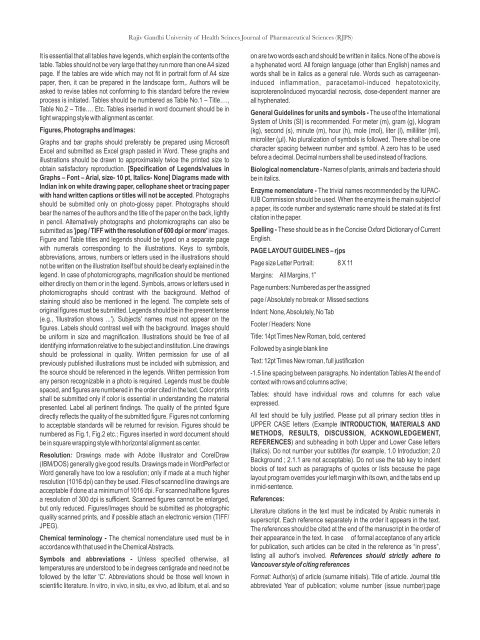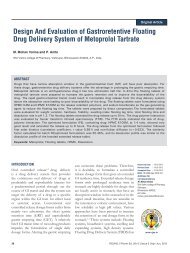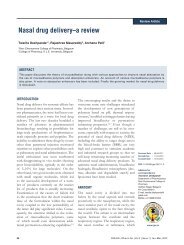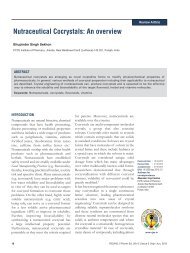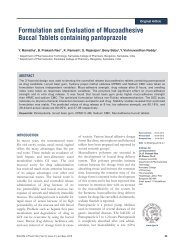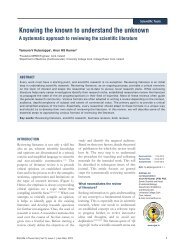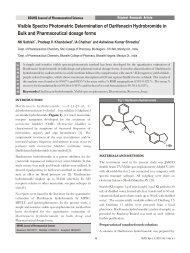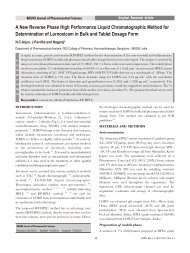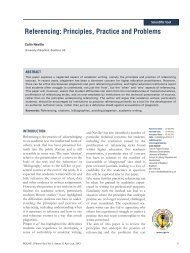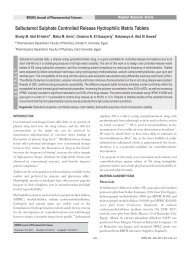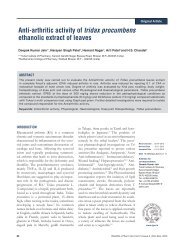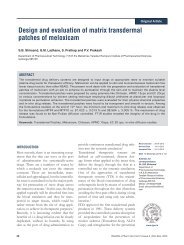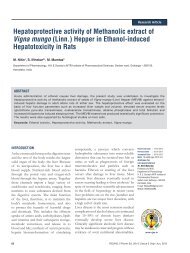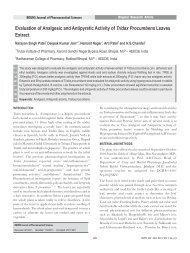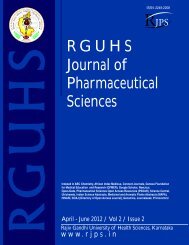Chitosan Loaded Mucoadhesive Microspheres of Gliclazide - Journal
Chitosan Loaded Mucoadhesive Microspheres of Gliclazide - Journal
Chitosan Loaded Mucoadhesive Microspheres of Gliclazide - Journal
Create successful ePaper yourself
Turn your PDF publications into a flip-book with our unique Google optimized e-Paper software.
It is essential that all tables have legends, which explain the contents <strong>of</strong> the<br />
table. Tables should not be very large that they run more than one A4 sized<br />
page. If the tables are wide which may not fit in portrait form <strong>of</strong> A4 size<br />
paper, then, it can be prepared in the landscape form,. Authors will be<br />
asked to revise tables not conforming to this standard before the review<br />
process is initiated. Tables should be numbered as Table No.1 – Title….,<br />
Table No.2 – Title…. Etc. Tables inserted in word document should be in<br />
tight wrapping style with alignment as center.<br />
Figures, Photographs and Images:<br />
Rajiv Gandhi University <strong>of</strong> Health Scinces <strong>Journal</strong> <strong>of</strong> Pharmaceutical Sciences (RJPS)<br />
Graphs and bar graphs should preferably be prepared using Micros<strong>of</strong>t<br />
Excel and submitted as Excel graph pasted in Word. These graphs and<br />
illustrations should be drawn to approximately twice the printed size to<br />
obtain satisfactory reproduction. [Specification <strong>of</strong> Legends/values in<br />
Graphs – Font – Arial, size- 10 pt, Italics- None] Diagrams made with<br />
Indian ink on white drawing paper, cellophane sheet or tracing paper<br />
with hand written captions or titles will not be accepted. Photographs<br />
should be submitted only on photo-glossy paper. Photographs should<br />
bear the names <strong>of</strong> the authors and the title <strong>of</strong> the paper on the back, lightly<br />
in pencil. Alternatively photographs and photomicrographs can also be<br />
submitted as 'jpeg / TIFF with the resolution <strong>of</strong> 600 dpi or more' images.<br />
Figure and Table titles and legends should be typed on a separate page<br />
with numerals corresponding to the illustrations. Keys to symbols,<br />
abbreviations, arrows, numbers or letters used in the illustrations should<br />
not be written on the illustration itself but should be clearly explained in the<br />
legend. In case <strong>of</strong> photomicrographs, magnification should be mentioned<br />
either directly on them or in the legend. Symbols, arrows or letters used in<br />
photomicrographs should contrast with the background. Method <strong>of</strong><br />
staining should also be mentioned in the legend. The complete sets <strong>of</strong><br />
original figures must be submitted. Legends should be in the present tense<br />
(e.g., 'Illustration shows ...'). Subjects' names must not appear on the<br />
figures. Labels should contrast well with the background. Images should<br />
be uniform in size and magnification. Illustrations should be free <strong>of</strong> all<br />
identifying information relative to the subject and institution. Line drawings<br />
should be pr<strong>of</strong>essional in quality. Written permission for use <strong>of</strong> all<br />
previously published illustrations must be included with submission, and<br />
the source should be referenced in the legends. Written permission from<br />
any person recognizable in a photo is required. Legends must be double<br />
spaced, and figures are numbered in the order cited in the text. Color prints<br />
shall be submitted only if color is essential in understanding the material<br />
presented. Label all pertinent findings. The quality <strong>of</strong> the printed figure<br />
directly reflects the quality <strong>of</strong> the submitted figure. Figures not conforming<br />
to acceptable standards will be returned for revision. Figures should be<br />
numbered as Fig.1, Fig.2 etc.; Figures inserted in word document should<br />
be in square wrapping style with horizontal alignment as center.<br />
Resolution: Drawings made with Adobe Illustrator and CorelDraw<br />
(IBM/DOS) generally give good results. Drawings made in WordPerfect or<br />
Word generally have too low a resolution; only if made at a much higher<br />
resolution (1016 dpi) can they be used. Files <strong>of</strong> scanned line drawings are<br />
acceptable if done at a minimum <strong>of</strong> 1016 dpi. For scanned halftone figures<br />
a resolution <strong>of</strong> 300 dpi is sufficient. Scanned figures cannot be enlarged,<br />
but only reduced. Figures/Images should be submitted as photographic<br />
quality scanned prints, and if possible attach an electronic version (TIFF/<br />
JPEG).<br />
Chemical terminology - The chemical nomenclature used must be in<br />
accordance with that used in the Chemical Abstracts.<br />
Symbols and abbreviations - Unless specified otherwise, all<br />
temperatures are understood to be in degrees centigrade and need not be<br />
followed by the letter 'C'. Abbreviations should be those well known in<br />
scientific literature. In vitro, in vivo, in situ, ex vivo, ad libitum, et al. and so<br />
on are two words each and should be written in italics. None <strong>of</strong> the above is<br />
a hyphenated word. All foreign language (other than English) names and<br />
words shall be in italics as a general rule. Words such as carrageenaninduced<br />
inflammation, paracetamol-induced hepatotoxicity,<br />
isoproterenolinduced myocardial necrosis, dose-dependent manner are<br />
all hyphenated.<br />
General Guidelines for units and symbols - The use <strong>of</strong> the International<br />
System <strong>of</strong> Units (SI) is recommended. For meter (m), gram (g), kilogram<br />
(kg), second (s), minute (m), hour (h), mole (mol), liter (l), milliliter (ml),<br />
microliter (µl). No pluralization <strong>of</strong> symbols is followed. There shall be one<br />
character spacing between number and symbol. A zero has to be used<br />
before a decimal. Decimal numbers shall be used instead <strong>of</strong> fractions.<br />
Biological nomenclature - Names <strong>of</strong> plants, animals and bacteria should<br />
be in italics.<br />
Enzyme nomenclature - The trivial names recommended by the IUPAC-<br />
IUB Commission should be used. When the enzyme is the main subject <strong>of</strong><br />
a paper, its code number and systematic name should be stated at its first<br />
citation in the paper.<br />
Spelling - These should be as in the Concise Oxford Dictionary <strong>of</strong> Current<br />
English.<br />
PAGE LAYOUT GUIDELINES – rjps<br />
Page size Letter Portrait: 8 X 11<br />
Margins: All Margins, 1”<br />
Page numbers: Numbered as per the assigned<br />
page / Absolutely no break or Missed sections<br />
Indent: None, Absolutely, No Tab<br />
Footer / Headers: None<br />
Title: 14pt Times New Roman, bold, centered<br />
Followed by a single blank line<br />
Text: 12pt Times New roman, full justification<br />
-1.5 line spacing between paragraphs. No indentation Tables At the end <strong>of</strong><br />
context with rows and columns active;<br />
Tables: should have individual rows and columns for each value<br />
expressed.<br />
All text should be fully justified. Please put all primary section titles in<br />
UPPER CASE letters (Example INTRODUCTION, MATERIALS AND<br />
METHODS, RESULTS, DISCUSSION, ACKNOWLEDGEMENT,<br />
REFERENCES) and subheading in both Upper and Lower Case letters<br />
(Italics). Do not number your subtitles (for example, 1.0 Introduction; 2.0<br />
Background ; 2.1.1 are not acceptable). Do not use the tab key to indent<br />
blocks <strong>of</strong> text such as paragraphs <strong>of</strong> quotes or lists because the page<br />
layout program overrides your left margin with its own, and the tabs end up<br />
in mid-sentence.<br />
References:<br />
Literature citations in the text must be indicated by Arabic numerals in<br />
superscript. Each reference separately in the order it appears in the text.<br />
The references should be cited at the end <strong>of</strong> the manuscript in the order <strong>of</strong><br />
their appearance in the text. In case <strong>of</strong> formal acceptance <strong>of</strong> any article<br />
for publication, such articles can be cited in the reference as “in press”,<br />
listing all author's involved. References should strictly adhere to<br />
Vancouver style <strong>of</strong> citing references<br />
Format: Author(s) <strong>of</strong> article (surname initials). Title <strong>of</strong> article. <strong>Journal</strong> title<br />
abbreviated Year <strong>of</strong> publication; volume number (issue number):page


